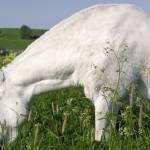Excessive Salivation and Photosensitization in Horses: Clover Identified

Horses love to munch on clover, a sweet legume, but did you know that overconsumption of certain types of clover can potentially be toxic to horses? Different clovers present different challenges for horses.
While healthy stands of white and red clover are not toxic to horses, these plants might harbor a fungus that manifests during stressful growing conditions, such as drought. This fungus produces a harmful mycotoxin. The most common fungus to infect white and red clover is known as “black patch” because of the bronze or black spots it forms on plant stems and leaves. The fungus contains slaframine, a toxin that stimulates the salivary glands and causes excessive drooling, known as “slobbers.” While slaframine is not fatal, horses should be removed from fields if they show signs of slobbers.
A different health concern is associated with alsike clover. Signs of alsike clover toxicity are sensitivity to sunlight, known as photosensitivity, and big liver disease, though the causative agent is unknown. Photosensitivity most often occurs when a horse consumes wet alsike clover. If the horse’s skin is damp or wet, the alsike clover may cause lesions or sores. Swelling of the tongue is also a concern and, at worst, may cause difficulty in chewing or swallowing. Sunburn and reddened skin around the muzzle or unpigmented areas are signs of photosensitivity. Long-term overconsumption of alsike clover may result in an enlarged liver, the result of tissue remodeling and being replaced with connective tissue, which causes progressive loss of liver function. The horse may develop yellowing of the eyes and gums as well as unexplained weight loss.
Other varieties of clover, such as sweet clover (Melilotus species) and crimson clover (Trifolium incarnatum), may also cause health problems, with toxicity signs including slobbers, colic, bloating, diarrhea, weakness, abnormal heartbeat, and abortion in pregnant mares.
The immediate treatment for clover toxicity is to remove the affected horse from grazing areas that contain the plant. Other cures or treatments are unknown. Mowing affected fields may help, but removing horses from the source is the best plan of action. Frequently, symptoms resolve quickly once the horse is removed from the clover, but don’t hesitate to contact your vet for an evaluation. If your pasture is overrun with clover, you may need to renovate and reseed it with a pasture mix appropriate for horses.
Consumption of most clover grown in normal environmental conditions is not harmful to horses, especially when it’s one of many plants flourishing in a grazing area. In some instances, clover is impossible to avoid in a pasture. If your horse takes a few bites of clover, especially when mixed with other pasture plants, it is unlikely to produce an adverse reaction. Each horse may also have a different threshold for tolerance before signs of toxicity appear. Your veterinarian should be consulted immediately for an evaluation and diagnosis if any unusual signs appear. Keep a close eye on your horse during grazing season, and check your pastures for signs of potentially toxic plants.
Unsure what pasture plants might be harmful to your horses and ponies? Ask a Kentucky Equine Research nutrition advisor for assistance.








